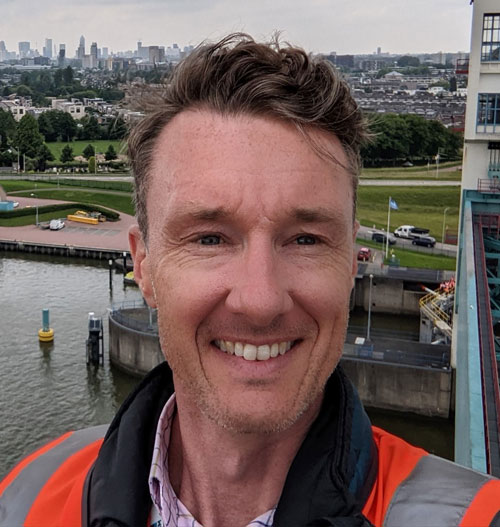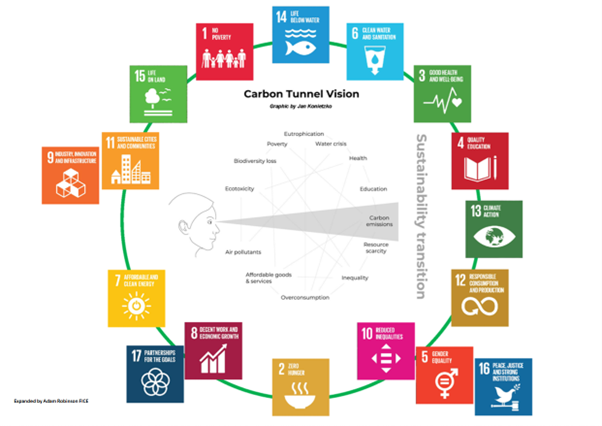Authors: Adam Robinson FICE, Environment Agency

Adam Robinson FICE, Environment Agency, calls on industry to adopt United Nations Sustainable Development Goals (UNSDGs) standards to help inform infrastructure planning and delivery.
Following on from the publication of the ‘Boston tidal barrier, UK: adapting to climate change and delivering social outcomes’, I have continued to reflect and consider the implications of how we as civil engineers are responding to the climate emergency and the use of United Nations Sustainable Development Goals (UNSDGs) as a tool to tell a story to better support and provide a depth to the community benefits that our work delivers, and how this can add to our assurance and approvals processes.
They can do this through a process of setting goals to deliver the most beneficial sustainable and economic solutions that support or drive the most advantageous investment choice to deliver much wider benefits than what would traditionally be delivered.
We collectively understand the inherent benefits that civil engineers bring to how society is, and how we deliver the critical infrastructure to enable our daily lives to continue in the way that is now expected, and how many people do not understand or appreciate this.
What we can all see is the continued escalation of the climate emergency that is occurring now, in the news, in articles we read and the impacts on our capital cities across the world and what these impacts are starting to look like, but they are only likely to be the tip of the iceberg of what will occur for many more years to come.
The primary Boston Barrier was commissioned and became operational on the 16 December 2020. It was first operated in November 2021 and has since been closed to protect Boston, due to high tides, on four separate occasions since it was commissioned.
I’ve continued to discuss and promote the use of the UNSDGs both within the Environment Agency and with our global partners at Rijkswaterstaat in the Netherlands, the US Army Corps of Engineers and Texas A&M University, the Venice Water Authority and the Public Utility Board in Singapore.
Let the UNSDGs lead the way
So why am I so passionate about the UNSDGs. They can enable us to consider and assess the impacts of our investments in infrastructure in a very different way. They provide a structure that allows us to consistently assess and record the impacts of our interventions, but in a way that looks at the wider benefits to our communities or even humanity as a whole.
We typically look at the benefit cost ratio (BCR) of our works with a standardised approach using the Outcome Measures (OM) framework to inform decisions about where to invest our Flood and Coastal Erosion Risk Management (FCERM) grant in aid funding.
We look at the Outcome Measures 2 (OM2) ‘Households at flood risk’ category to assess our schemes and that provides us with our estimated funding allocation for a scheme. With this information Government Partnership Funding Policy prioritises investment in reducing flood risk to people, homes and livelihoods in the assessment of eligibility for Flood Defence Grant in Aid (FDGiA) and encourages public and private investment.
Boston was fortunate to be both a Government guaranteed funded scheme in the 2014 Autumn statement, but also had adequate benefits to draw upon to be a fully funded grant in aid scheme through the FDGiA process. Not all programmes are like this, and when that is the case, we are required to seek partnership funding to bridge the gap to deliver schemes that better protect people and the environment, and this can unfortunately take time.
[UNSDGs] provide a structure that allows us to consistently assess and record the impacts of our interventions, but in a way that looks at the wider benefits to our communities or even humanity as a whole.
This is where UNSDGs can play a part. By using the UNSDGs as a framework to assess the wider community benefits that are likely to occur through the delivery of our scheme investment in a community, we can begin to tell a better story that encompasses much wider benefits that are being realised in the community other than the obvious flood risk benefits.
For example, if the local school, primary or secondary or both, are flooded what are the impacts to the community? Department of Education (DoE) must step in with additional funding to support the school in its recovery programme (SDG4), the school facilities are damaged meaning our children are no longer being taught in their classrooms. They may be moved to temporary classrooms or other spaces in the school that were not impacted (SDG1). Maybe this space was the sports hall. This space can now no longer be used as a sports facility in the school, so our children are missing out on the sports and physical education elements of their learning (SDG3).
You can see that the impacts of a flood on other local infrastructure and assets we rely on can quickly escalate. This example could easily have been a local hospital, sub-station, water treatment works or the local fire station (SDG3 and 9). My point is that other government agencies and national infrastructure providers are needed to step in and incur costs to recover their assets and this all links to SDG9, infrastructure, and SDG11 sustainable cities and communities.
So, by using UNSDGs, we can become better at articulating the story of what investment in our sector achieves. We should use this understanding to seek the appropriate funding from all stakeholders to ensure that our schemes are funded correctly.
Under the current rules, some of our key schemes are marginal using the BCR process – but if we can begin to articulate the wider savings to central government through how our investment helps support the long-term viability of communities and the critical infrastructure they rely on, then maybe we can begin to streamline our approvals processes and continue to deliver even more schemes that protect people and the environment.
Beyond carbon emissions
We are responding to how we monitor, assess, and reduce our embodied and operational carbon in our construction, and this topic is front and centre in everyone’s minds. But we must be mindful not to fall into the carbon tunnel vision trap as defined by Jan Konietzko where we are expecting carbon to be the magical key to fixing everything.
Reading his article, I really liked his take on this topic and the sustainability transition, and how much more it is, but we are generally only concentrating on carbon emissions both in our profession and in the wider world. Carbon emissions are important, but they are not the be all and end all. What I saw though was how his thoughts very easily map across the to the UNSDG framework.

We have many ways of describing similar topics, but we have no consistently agreed profession wide agreed method to do this.
A call for change
If we collectively adopt the UNSDG standards across industry and begin using the structure of the UNSDGs at the outset of our work assessments – Strategic Outline Case (SOC), Outline Business Case (OBC) and Full Business Case (FBC). We can start understanding the wider story of the work that we delivery to communities and members of the public, which we are all part of.
This will allow us to consider those wider community benefits that we can, and will realise, through our investments. We will be able to articulate them clearly and concisely through the approvals process allowing further benefits to be clearly allocated to schemes by ourselves, as well as our partners, making partnership funding an easier process but more importantly enabling us to make our clear case for investment to HM Treasury.
So, what would I like to see? Industry wide acceptance of the UNSDGs. Assessment of the wider scheme benefits begun at the outset of our business cases at SoC, better evidence as to why we are delivering our scheme in a community that is not just linked to the OM2’s achieved, and maybe recognition that we should reset the OM2’s claimed the first time our assets are deployed to protect the community or city.
The Thames Barrier currently protects £321billion of UK residential, commercial and heritage sites in London. Each time it is deployed it protects a vast proportion of this UK asset, is it right we can only claim those benefits once?
Let’s seize this moment to embrace the transformative potential of UNSDGs. Let us go beyond mere metrics and embark on a journey to secure a sustainable future. Our structures, which not only bridge gaps but also create enduring positive impacts, can be a driving force for positive change.
With the UNSDGs as our guiding compass, we can redefine success, acknowledging the profound and far-reaching consequences of our actions. By aligning ourselves with the goals we can pave the way forward for a multitude of community and environmental benefits. Through reduced carbon emissions, improved water quality, enhanced biodiversity, and the preservation of our precious natural resources, we can make a tangible difference.
Together, as stewards of both infrastructure and the environment, we hold the power to shape a brighter, more sustainable future for all. Let's work collectively towards a legacy that not only strengthens our infrastructure but also safeguards our planet for generations to come.

Sustainable structures and infrastructures
We are passionate about supporting researchers, policymakers, and practitioners in their efforts to minimise the environmental impact of structures and infrastructures.
